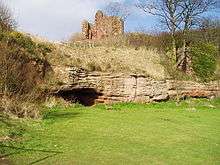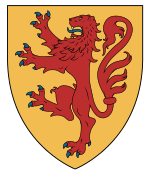Earl of Fife
| Earldom of Fife | |
|---|---|
|
Or, a lion rampant gules | |
| Creation date | 11th century? |
| Peerage | Peerage of Scotland |
| First holder | Ethelred |
| Last holder | Murdoch |
| Extinction date | 1425 |
| Seat(s) | Macduff's Castle |
The Earl of Fife or Mormaer of Fife was the ruler of the province of Fife in medieval Scotland, which encompassed the modern counties of Fife and Kinross. Due to their royal ancestry, the Earls of Fife were the highest ranking nobles in the realm, and had the right to crown the King of Scots.
Held by the MacDuff family until it passed by resignation to the Stewarts, the earldom ended on the forfeiture and execution of Duke Murdoch in 1425. The earldom was revived in 1759 with the style of Earl Fife for William Duff, a descendant of the MacDuffs. His great-great-grandson, the 6th Earl Fife, was made Earl of Fife in 1885 and Duke of Fife in 1889.
Medieval earldom

Mormaer of Fife
The Mormaers of Fife, by the 12th century, had established themselves as the highest ranking native nobles in Scotland. They frequently held the office of Justiciar of Scotia - highest brithem in the land - and enjoyed the right of crowning the Kings of the Scots. The Mormaer's function, as with other medieval Scottish lordships, was partly kin-based. Hence, in 1385, the Earl of Fife, seen as the successor of the same lordship, is called capitalis legis de Clenmcduffe (=Lord of the Law of the Children of Macduff).
The lordship existed in the Middle Ages until its last earl, Murdoch (Muireadhach), Duke of Albany, was executed by James I of Scotland.
Chief of Clan Macduff
The deputy or complementary position to mormaer or earl of Fife was leadership as Chief (ceann) of Clan MacDuff (clann meic Duibh). There is little doubt that the style MacDuib, or Macduff, derives from the name of King Cináed III mac Duib, and ultimately from this man's father, King Dub (d. 966).[1] Compare, for instance, that Domhnall, Lord of the Isles, signed a charter in 1408 as MacDomhnaill. The descendants of Cináed III adopted the name in the same way that the descendants of Brian Bóruma mac Cennétig called themselves Uí Briain, although it does seem that at least initially MacDuff was a style reserved for the man who held the Mormaership of Fife.
The chieftaincy of the clan was not always held by the mormaer, especially after the mormaerdom became subject to the laws of feudal primogeniture in the reign of Donnchadh I. For example, at the Battle of Falkirk, it is the head of the clan who led the men of Fife, rather than the Mormaer.
End of Macduff line
The Macduff line continued without interruption until the time of Isabella, the only child of Donnchad (Duncan) IV, Earl of Fife, and his wife Mary de Monthermer. She succeeded her father as suo jure Countess of Fife on his death in 1358, making her one of the most eligible maidens in Scotland. She married four times, but all her husbands died within a few years of their marriage. In 1371 she was persuade to name Robert Stewart, Earl of Menteith (later Duke of Albany) as her heir, who was her brother-in-law by her second marriage to Walter Stewart. He thus succeeded her as twelfth Earl of Fife on her death in 1389. Duke Robert was succeeded as Duke of Albany, Earl of Fife, etc. by his son Murdoch in 1420. Duke Murdoch was forfeited and executed in 1425, due to his father's part in the death of Prince David, Duke of Rothesay. Thus the earldom of Fife came to an end.
Coat of arms
The arms of the earldom of Fife are or, a lion rampant gules, that is, a red lion rampant on gold. These arms are testament to the Earls' royal connection, as they differ to the King's arms only in the exclusion of the flowered border, or royal tressure; in fact it is possible that the royal arms are actually a differenced version of those of the Earl.[2] The device of a lion is attested for the first time on the seal of the tenth Earl, but had probably been used for a long time before this, though some early seals show a different shield, bearing pallets or vertical stripes.[3]
The arms of the Earl of Fife are the basis for the arms of Fife Council, which show a knight on horseback in full armorial regalia, his shield, helm and the caparison of his horse bedecked with red lions.[2] The Fife lion also appears in the first quarter of the Duke of Fife's arms.[4]
Earls Fife (1759)
The earldom of Fife was resurrected in 1759 for William Duff, after he proved his descent from the original Earls of Fife. This title was in the Peerage of Ireland, notwithstanding that Fife is in Scotland; the "of" was also excluded, for reasons not ascertained.
Earls of Fife (1885)
The title of Earl of Fife in the Peerage of the United Kingdom was created in 1885 by Queen Victoria for Alexander Duff, 6th Earl Fife (1849–1912).[5] He married Princess Louise, the third child and eldest daughter of Albert, Prince of Wales, later King Edward VII; two days after the wedding, Queen Victoria elevated him to the dignity of Duke of Fife in the Peerage of the United Kingdom.[6] When it became clear that Alexander was not going to have a son, Queen Victoria created a second dukedom of Fife which could pass through the female line. After his death in 1912, the dukedom of Fife passed to his eldest daughter Lady Alexandra, and his other titles, including the 1759 earldom, became extinct. The fourth and current Duke of Fife is David Carnegie, the grandson of Duke Alexander's younger daughter.
List of holders
Mormaers of Fife
- ? Giric mac Cináeda meic Duib
- ?
- Macduib (= Shakespeare's MacDuff) (fl. 1057–1058)
- Causantín, Earl of Fife, (fl. 1095–1128)
- See Mormaer Beth and Ethelred of Scotland for common confusion here
- Gille Míchéil, Earl of Fife (1130–1133)
- Donnchadh I, Earl of Fife (1133–1154)
- Donnchadh II, Earl of Fife (1154–1204)
- Maol Choluim I, Earl of Fife (1204–1228)
- Maol Choluim II, Earl of Fife (1228–1266)
- Colbán, Earl of Fife, (1266–1270/2)
- Donnchadh III, Earl of Fife (1270/2–1288)
- Donnchadh IV, Earl of Fife (1288–1353), considered by King David II to have forfeited the earldom
- Sir William Ramsay of Colluthie, Earl of Fife (1358-c1360), created by King David II
- Isabella, Countess of Fife, (1361–1371), daughter of Donnchadh IV, was persuaded to resign the earldom to
- Robert Stewart, Earl of Fife (1371–1420)
- Murdoch Stewart, Duke of Albany, Earl of Fife (1420–1425)
Earls Fife
- William, Earl Fife (c. 1696-1763)
- James, Earl Fife (1729-1809)
- Alexander, Earl Fife (1731-1811)
- James, Earl Fife (1776-1857)
- James, Earl Fife (1814-1879)
Dukes of Fife
- Alexander, Duke of Fife (1849-1912)
- Alexandra, Duchess of Fife (1891-1959)
- James, Duke of Fife (1929-2015)
- David, Duke of Fife (born 1961)
Notes
- ↑ John Bannerman, "MacDuff of Fife" p. 24.
- 1 2 Patton, David (1977). Arms of the County Councils of Scotland. Port Charlotte: Argyll Reproductions Ltd.
- ↑ MacDonald, William (1904). Scottish Armorial Seals. Edinburgh: William Green and Sons.
- ↑ "Fife, Duke of (UK, 1900)". Cracroft's Peerage. 2013.
- ↑ The London Gazette: no. 25490. p. 3239. 14 July 1885.
- ↑ The London Gazette: no. 25958. p. 4077. 27 July 1889.
References
- Grant, Rev'd Alexander, "The Ancient Earls of Fife", in Sir James Balfour Paul (ed.) The Scots Peerage, Volume IV, (Edinburgh, 1907), pp. 1-15
- Bannerman, John, "MacDuff of Fife," in A. Grant & K.Stringer (eds.) Medieval Scotland: Crown, Lordship and Community, Essays Presented to G.W.S. Barrow, (Edinburgh, 1993), pp. 20–38
- Barrow, G. W. S., Robert Bruce and the Community of the Realm of Scotland, (Edinburgh, 1988)
- Barrow, G.W.S. Earl's of Fife in the 12th Century, (Proceedings of the Society of Antiquaries of Scotland, 1952–53), pp. 51–61.
- Lawrie, Sir Archibald C., Early Scottish Charters Prior to A.D. 1153, (Glasgow, 1905), no. XXXVI, pp. 28–31, pp. 283–84
- Roberts, John L., Lost Kingdoms: Celtic Scotland and the Middle Ages, (Edinburgh, 1997)
External links
- Stirnet: "Fife1"
- University of Glasgow: Genealogical Chart of Early Gaelic Earls (link does not work correctly; after following this link, click on the Genealogical chart of mormaír (earls) of Fife, showing use of Gaelic names link)
| ||||||
